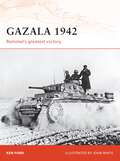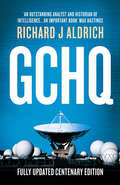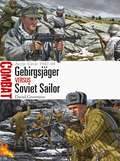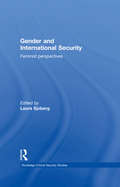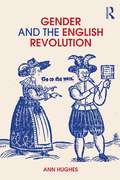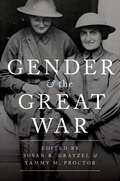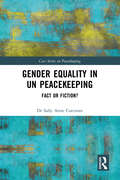- Table View
- List View
The Gathering Storm: the brand-new Morland Dynasty novel in the beloved historical series (Morland Dynasty #36)
by Cynthia Harrod-EaglesThe eagerly-awaited return to the acclaimed Morland Dynasty series, and the 100th novel by Cynthia Harrod-EaglesEngland, 1936The reign of Edward VIII has begun, but danger for the monarchy already looms on the horizon. At home in Morland Place, Polly Morland feels alone and abandoned, with her brother summoned to France by his old employer. James soon finds himself travelling to Russia, whereas Polly will voyage on the Queen Mary with New York - and a long-lost love - her destination. Soon the family are scattered to the four winds, from Hollywood to war-torn Spain. Working for the Air Ministry on new fighter planes, Jack fears that his children are not taking the increasingly tense situation in Europe seriously enough. The nation is divided over which is the greater thread: Communist Russia, or Fascist Germany. As the storms of war gather, they will threaten to overwhelm the Morlands and destroy all that they have worked for...The BRAND-NEW novel in the acclaimed Morland Dynasty historical fiction series with over a quarter of a million copies sold. The perfect read for fans of Downton Abbey, Lucinda Riley and The Crown
Gathering Storm
by Don PendletonReady to respond to any threat against America, her allies or world stability, Stony Man is a strictly off-the-books operation whose orders come straight from the Oval Office.
Gathering to Save a Nation: Lincoln and the Union's War Governors (Civil War America)
by Stephen D. EngleIn this rich study of Union governors and their role in the Civil War, Stephen D. Engle examines how these politicians were pivotal in securing victory. In a time of limited federal authority, governors were an essential part of the machine that maintained the Union while it mobilized and sustained the war effort. Charged with the difficult task of raising soldiers from their home states, these governors had to also rally political, economic, and popular support for the conflict, at times against a backdrop of significant local opposition.Engle argues that the relationship between these loyal-state leaders and Lincoln's administration was far more collaborative than previously thought. While providing detailed and engaging portraits of these men, their state-level actions, and their collective cooperation, Engle brings into new focus the era's complex political history and shows how the Civil War tested and transformed the relationship between state and federal governments.
The Gatling Gun (Weapon)
by Johnny Shumate Peter SmithurstA unique chapter in the history of firearms, the multibarrel, hand-cranked Gatling gun was one of the first practical rapid-fire weapons ever to be used in battle. It changed warfare by introducing the capability to project deadly, high-intensity fire on the battlefield, and portended the devastation that automatic weapons would wreak in World War I. During its 50-year career, it saw widespread service with US, British, and other forces on a host of battlefields through conflicts in Zululand and the American West, to the Spanish-American War. Although it saw widespread use in the hands of industrialized nations against various groups of indigenous native warriors, it was famously left behind by Custer at the battle of the Little Bighorn, where some argue it could have made all the difference. Featuring full-colour artwork plus contemporary and close-up photographs, this engaging study investigates the origins, development, combat use, and lasting influence of the formidable Gatling gun.
The Gatling Gun (Weapon #40)
by Johnny Shumate Peter SmithurstA unique chapter in the history of firearms, the multibarrel, hand-cranked Gatling gun was one of the first practical rapid-fire weapons ever to be used in battle. It changed warfare by introducing the capability to project deadly, high-intensity fire on the battlefield, and portended the devastation that automatic weapons would wreak in World War I. During its 50-year career, it saw widespread service with US, British, and other forces on a host of battlefields through conflicts in Zululand and the American West, to the Spanish-American War. Although it saw widespread use in the hands of industrialized nations against various groups of indigenous native warriors, it was famously left behind by Custer at the battle of the Little Bighorn, where some argue it could have made all the difference. Featuring full-colour artwork plus contemporary and close-up photographs, this engaging study investigates the origins, development, combat use, and lasting influence of the formidable Gatling gun.
The Gauntlet and the Broken Chain (The Rotstorm #1)
by Ian GreenFor 312 years the rotstorm has blighted the ruins of the Ferron Empire.Born of an unholy war between gods themselves, it scours the land with acid mists and deadly lightning, spawning twisted monstrosities from its nightmarish depths.On the Stormwall, the men and women of the Stormguard maintain their vigil - eyes sharp, blades sharper - defending the Undal Protectorate from the worst of the rotstorm's corruption.But behind the storm front, something is stirring, kindling the embers of an ancient conflict and a plan to kill a god.Will Stormguard steel be enough to meet the coming tempest?---The land is gripped in a claw winter.The rotstorm has breached the walls of Undal City.The children of the storm have claimed the Northern Marches.The deathless mage has been unchained.The dead god hunts again.And Floré will raise her gauntlets against them all.
The Gauntlet and the Burning Blade (The Rotstorm)
by Ian GreenIn the second instalment of the Rotstorm series, heroine Floré must continue to fight back against the encroaching children of the storm – but now her daughter Marta is dying, too. Can Floré save her daughter, and her people, from threats familiar and new?Break the chains. Hold your strength. Burn your foes.Once a warrior of the Stormguard Commandos, Floré wrought horrors in the rotstorm to protect her people. She did her duty and swore to leave the bloodshed behind. But when her daughter, Marta, was kidnapped, Floré was forced to once again raise her gauntlet against the devils of Ferron to bring her home.Now Marta is dying from the skein-magic she inherited from her father, and the Protectorate is weakened by the absence of the whitestaffs. The mystical order of healers and sages fled to their island citadel of Riven when strange orbs cut through the night.Floré and her comrades must race to find a cure for Marta, to find the truth of the whitestaffs' betrayal, and to fight back against the encroaching children of the storm.Floré has taken up her gauntlets and her sword to keep her people safe – but steel alone might not be enough...'Excellent, vivid worldbuilding... A gripping story with cinematic detail' British Fantasy Society 'Epic action, deep world-building, and colourful characters make for a magical debut, forged in compelling inspirations... There's plenty more magic to come' The Publishing Planet
The Gauntlet and the Fist Beneath (The Rotstorm)
by Ian GreenShortlisted for Best Newcomer at the 2022 British Fantasy Awards Fight the Storm. Protect your people.The endless rotstorm rages over the ruins of the Ferron Empire. Floré would never let the slavers of the Empire rise again. As a warrior of the Stormguard Commandos, she wrought horrors in the rotstorm to protect her people. She did her duty and left the bloodshed behind.Fight for your family.Floré's peace is shattered when blazing orbs of light cut through the night sky and descend on her village. Her daughter is abducted and Floré is forced into a chase across a land of twisted monsters and ancient gods. She must pursue the mysterious orbs, whose presence could herald the return of the Empire she spent her entire life fighting.Destroy your enemies.Now, Floré must take up the role she had sworn to put aside and become the weapon the Stormguard trained her to be, to save not only her daughter, but her people...Read this action-packed and unique fantasy adventure from debut Scottish author, Ian Green. Perfect for fans of Brandon Sanderson's Stormlight Archive series or Sam Sykes' Seven Blades In Black.
Gazala 1942: Rommel's greatest victory (Campaign)
by John White Ken FordFollowing a lull in the desert war which saw the Germans and British reinforce their armies, Rommel suddenly attacked British fortifications with an assault on the northern sector of the British line near Gazala. Pinning down the British in the north and outflanking the 1st Free French Brigade, Rommel succeeded in encircling the main British positions, trapping them in what became known as 'The Cauldron'. With thousands of British soldiers killed or taken prisoner, this was a devastating defeat for the Allies. Accompanied by contemporary photographs and maps depicting the movement of both armies, Ken Ford provides a masterful study of Rommel, the 'Desert Fox', at the height of his powers as he swept the British army back to the site of their final stand at El Alamein.
Gazala 1942: Rommel's greatest victory (Campaign #196)
by John White Ken FordFollowing a lull in the desert war which saw the Germans and British reinforce their armies, Rommel suddenly attacked British fortifications with an assault on the northern sector of the British line near Gazala. Pinning down the British in the north and outflanking the 1st Free French Brigade, Rommel succeeded in encircling the main British positions, trapping them in what became known as 'The Cauldron'. With thousands of British soldiers killed or taken prisoner, this was a devastating defeat for the Allies. Accompanied by contemporary photographs and maps depicting the movement of both armies, Ken Ford provides a masterful study of Rommel, the 'Desert Fox', at the height of his powers as he swept the British army back to the site of their final stand at El Alamein.
GCHQ: The Uncensored Story Of Britain's Most Secret Intelligence Agency
by Richard AldrichAs we become ever-more aware of how our governments “eavesdrop” on our conversations, here is a gripping exploration of this unknown realm of the British secret service: Government Communication Headquarters (GCHQ).
Gebirgsjäger vs Soviet Sailor: Arctic Circle 1942–44 (Combat #30)
by Johnny Shumate David GreentreeIn 1941–44, Nazi Germany's Gebirgsjäger - elite mountain troops - clashed repeatedly with land-based units of the Soviet Navy during the mighty struggle on World War II's Eastern Front. Formed into naval infantry and naval rifle brigades, some 350,000 of Stalin's sailors would serve the Motherland on land, playing a key role in the defence of Moscow, Leningrad, and Sevastopol. The Gebirgsjäger, many among them veterans of victories in Norway and then Crete, would find their specialist skills to be at a premium in the harsh terrain and bitter weather encountered at the northern end of the front line. Operating many hundreds of miles north of Moscow, the two sides endured savage conditions as they fought one another inside the Arctic Circle.Featuring archive photographs, specially commissioned artwork and expert analysis, this is the absorbing story of the men who fought and died in the struggle for the Soviet Union's northern flank at the height of World War II.
Gebirgsjäger vs Soviet Sailor: Arctic Circle 1942–44 (Combat)
by Johnny Shumate David GreentreeIn 1941–44, Nazi Germany's Gebirgsjäger - elite mountain troops - clashed repeatedly with land-based units of the Soviet Navy during the mighty struggle on World War II's Eastern Front. Formed into naval infantry and naval rifle brigades, some 350,000 of Stalin's sailors would serve the Motherland on land, playing a key role in the defence of Moscow, Leningrad, and Sevastopol. The Gebirgsjäger, many among them veterans of victories in Norway and then Crete, would find their specialist skills to be at a premium in the harsh terrain and bitter weather encountered at the northern end of the front line. Operating many hundreds of miles north of Moscow, the two sides endured savage conditions as they fought one another inside the Arctic Circle.Featuring archive photographs, specially commissioned artwork and expert analysis, this is the absorbing story of the men who fought and died in the struggle for the Soviet Union's northern flank at the height of World War II.
Gelegenheit macht Kriege: Sonden im Militär
by Lutz UnterseherGeleitet von einer verbreiteten Vermutung wird danach gefragt, ob die relative Schwäche eines Gegners oder die Wahrnehmung besonderer Verwundbarkeit des jeweiligen Kontrahenten, also von günstigen Gelegenheiten für einen Angriff, tatsächlich den Ausbruch von offenen Feindseligkeiten wahrscheinlicher macht.
Gender and International Security: Feminist Perspectives (Routledge Critical Security Studies #17)
by Laura SjobergThis book defines the relationship between gender and international security, analyzing and critiquing international security theory and practice from a gendered perspective. Gender issues have an important place in the international security landscape, but have been neglected both in the theory and practice of international security. The passage and implementation of UN Security Council Resolution 1325 (on Security Council operations), the integration of gender concerns into peacekeeping, the management of refugees, post-conflict disarmament and reintegration and protection for non-combatants in times of war shows the increasing importance of gender sensitivity for actors on all fronts in global security. This book aims to improve the quality and quantity of conversations between feminist security studies and security studies more generally, in order to demonstrate the importance of gender analysis to the study of international security, and to expand the feminist research program in Security Studies. The chapters included in this book not only challenge the assumed irrelevance of gender, they argue that gender is not a subsection of security studies to be compartmentalized or briefly considered as a side issue. Rather, the contributors argue that gender is conceptually, empirically, and normatively essential to studying international security. They do so by critiquing and reconstructing key concepts of and theories in international security, by looking for the increasingly complex roles women play as security actors, and by looking at various contemporary security issues through gendered lenses. Together, these chapters make the case that accurate, rigorous, and ethical scholarship of international security cannot be produced without taking account of women’s presence in or the gendering of world politics. This book will be of interest to all students of critical security studies, gender studies and International Relations in general. Laura Sjoberg is Assistant Professor of Political Science at the University of Florida. She has a Phd in International Relations and Gender Studies from the University of Southern California and is the author of Gender, Justice, and the Wars in Iraq (2006) and, with Caron Gentry, Mothers, Monsters, Whores: Women's Violence in Global Politics (2007)
Gender and International Security: Feminist Perspectives (Routledge Critical Security Studies)
by Laura SjobergThis book defines the relationship between gender and international security, analyzing and critiquing international security theory and practice from a gendered perspective. Gender issues have an important place in the international security landscape, but have been neglected both in the theory and practice of international security. The passage and implementation of UN Security Council Resolution 1325 (on Security Council operations), the integration of gender concerns into peacekeeping, the management of refugees, post-conflict disarmament and reintegration and protection for non-combatants in times of war shows the increasing importance of gender sensitivity for actors on all fronts in global security. This book aims to improve the quality and quantity of conversations between feminist security studies and security studies more generally, in order to demonstrate the importance of gender analysis to the study of international security, and to expand the feminist research program in Security Studies. The chapters included in this book not only challenge the assumed irrelevance of gender, they argue that gender is not a subsection of security studies to be compartmentalized or briefly considered as a side issue. Rather, the contributors argue that gender is conceptually, empirically, and normatively essential to studying international security. They do so by critiquing and reconstructing key concepts of and theories in international security, by looking for the increasingly complex roles women play as security actors, and by looking at various contemporary security issues through gendered lenses. Together, these chapters make the case that accurate, rigorous, and ethical scholarship of international security cannot be produced without taking account of women’s presence in or the gendering of world politics. This book will be of interest to all students of critical security studies, gender studies and International Relations in general. Laura Sjoberg is Assistant Professor of Political Science at the University of Florida. She has a Phd in International Relations and Gender Studies from the University of Southern California and is the author of Gender, Justice, and the Wars in Iraq (2006) and, with Caron Gentry, Mothers, Monsters, Whores: Women's Violence in Global Politics (2007)
Gender and Power in the Third Reich: Female Denouncers and the Gestapo (1933-45)
by V. JoshiThis book examines the everyday operations of the Gestapo, the Nazi secret police. The Gestapo were able to detect the smallest signs of non-compliance with Nazi doctrines, especially 'crimes' pertaining to the private spheres of social, family, and sexual life. One of the key factors in the enforcement of Nazi policies was the willingness of German citizens to provide the authorities with information about suspected 'criminality'. This book examines women denouncers in Nazi Germany through close examination of the Gestapo files. The author seeks to answer questions about how women in particular used denunciation and why so many ordinary women denounced 'deviants and dissenters' to the Gestapo.
Gender and the English Revolution
by Ann HughesIn this fascinating and unique study, Ann Hughes examines how the experience of civil war in seventeenth-century England affected the roles of women and men in politics and society; and how conventional concepts of masculinity and femininity were called into question by the war and the trial and execution of an anointed King. Ann Hughes combines discussion of the activities of women in the religious and political upheavals of the revolution, with a pioneering analysis of how male political identities were fractured by civil war. Traditional parallels and analogies between marriage, the family and the state were shaken, and rival understandings of sexuality, manliness, effeminacy and womanliness were deployed in political debate. In a historiography dominated by military or political approaches, Gender and the English Revolution reveals the importance of gender in understanding the events in England during the 1640s and 1650s. It will be an essential resource for anyone interested in women’s history, feminism, gender or British History.
Gender and the English Revolution
by Ann HughesIn this fascinating and unique study, Ann Hughes examines how the experience of civil war in seventeenth-century England affected the roles of women and men in politics and society; and how conventional concepts of masculinity and femininity were called into question by the war and the trial and execution of an anointed King. Ann Hughes combines discussion of the activities of women in the religious and political upheavals of the revolution, with a pioneering analysis of how male political identities were fractured by civil war. Traditional parallels and analogies between marriage, the family and the state were shaken, and rival understandings of sexuality, manliness, effeminacy and womanliness were deployed in political debate. In a historiography dominated by military or political approaches, Gender and the English Revolution reveals the importance of gender in understanding the events in England during the 1640s and 1650s. It will be an essential resource for anyone interested in women’s history, feminism, gender or British History.
Gender and the First World War
by Christa Hämmerle Oswald Überegger Birgitta Bader ZaarThe First World War cannot be sufficiently documented and understood without considering the analytical category of gender. This exciting volume examines key issues in this area, including the 'home front' and battlefront, violence, pacifism, citizenship and emphasizes the relevance of gender within the expanding field of First World War Studies.
Gender and the Great War
by Susan R. Grayzel Tammy M. ProctorThe centenary of the First World War in 2014-18 offers an opportunity to reflect upon the role of gender history in shaping our understanding of this pivotal international event. From the moment of its outbreak, the gendered experiences of the war have been seen by contemporary observers and postwar commentators and scholars as being especially significant for shaping how the war can and must be understood. The negotiating of ideas about gender by women and men across vast reaches of the globe characterizes this modern, instrumental conflict. Over the past twenty-five years, as the scholarship on gender and this war has grown, there has never been a forum such as the one presented here that placed so many of the varying threads of this complex historiography into conversation with one another in a manner that is at once accessible and provocative. Given the vast literature on the war itself, scholarship on gender and various themes and topics provides students as well as scholars with a chance to think not only about the subject of the war but also the methodological implications of how historians have approached it. While many studies have addressed the national or transnational narrative of women in the war, none address both femininity and masculinity, and the experiences of both women and men across the same geographic scope as the studies presented in this volume.
Gender and Violence in British India: The Road to Amritsar, 1914-1919
by R. McLainIn British India, the years during and following World War I saw imperial unity deteriorate into a bitter dispute over "native" effeminacy and India's postwar fitness for self-rule. This study demonstrates that increasingly ferocious dispute culminated in the actual physical violence of the Amritsar Massacre of 1919.
Gender and warfare in the twentieth century: Textual representations
by Angela K. SmithGender and warfare in the twentieth century is a collection of exciting, accessible and very readable essays that span the twentieth century, exploring the ways in which men and women have both represented warfare, and represented themselves as participants in warfare. A range of contributors from different disciplines explore these representations by examining a wide variety of sources: fiction, film, personal diaries, memoirs, non-fiction, letters, oral testimonies and more. The collection ranges from the trenches of the Western Front, through the shell-shocked inter-war years, the civil war in Spain and the disparate battle fronts of World War Two, to the complexities of Vietnam and the late century Hollywood workings and re-workings of these conflicts. The focus on gendered readings provides a thread that binds these essays together to create a comprehensive and interesting picture of the legacy of twentieth-century warfare at the beginning of the new millennium.
Gender Equality in UN Peacekeeping: Fact or Fiction? (ISSN)
by Sally Anne CorcoranThis book investigates to what extent UNSCR 1325/WPS agenda has functioned in practice, to advance women’s equality and empowerment in the peacekeeping context and beyond.The book examines whether widespread implementation of UNSCR 1325 and the broader WPS agenda via gender mainstreaming in UN operations has translated into increased gender equality in peacekeeping operations, the broader UN institutional context and, by extension, the host countries in which missions are situated, via norm dissemination. The book investigates this via a review of the implementation of UNSCR1325 in the operations chosen as research sites over three snapshot years. The book undertakes a comparative analysis that scrutinizes if, how and under what conditions gender mainstreaming has succeeded as a strategy to advance gender equality by analyzing the factors/conditions that have led to successful gender mainstreaming across the operational context, and those that have impeded this outcome. The book concludes that, despite rhetorical commitments to women’s equality in peacekeeping since the passage of UNSCR 1325, progress on the ground has remained minimal, and that the operational environment continues to be discriminatory against women. Both quantitatively and qualitatively, women do not participate as equal partners in peacekeeping and continue to have less access to resources and decision-making power, overall. The book interrogates that by exploring the spaces available within law, policy and practice of the UN to pursue the human rights agenda of gender equality and considers whether UNSCR 1325 has enlarged those spaces. It also points to the irony of internal UN structures failing to adequately adapt to their own gender mainstreaming mandates, while those same structures have delivered some gender equality mandates successes externally, at local levels.This book will be of interest to students of peacekeeping, gender studies, and International Relations.
Gender Equality in UN Peacekeeping: Fact or Fiction? (ISSN)
by Sally Anne CorcoranThis book investigates to what extent UNSCR 1325/WPS agenda has functioned in practice, to advance women’s equality and empowerment in the peacekeeping context and beyond.The book examines whether widespread implementation of UNSCR 1325 and the broader WPS agenda via gender mainstreaming in UN operations has translated into increased gender equality in peacekeeping operations, the broader UN institutional context and, by extension, the host countries in which missions are situated, via norm dissemination. The book investigates this via a review of the implementation of UNSCR1325 in the operations chosen as research sites over three snapshot years. The book undertakes a comparative analysis that scrutinizes if, how and under what conditions gender mainstreaming has succeeded as a strategy to advance gender equality by analyzing the factors/conditions that have led to successful gender mainstreaming across the operational context, and those that have impeded this outcome. The book concludes that, despite rhetorical commitments to women’s equality in peacekeeping since the passage of UNSCR 1325, progress on the ground has remained minimal, and that the operational environment continues to be discriminatory against women. Both quantitatively and qualitatively, women do not participate as equal partners in peacekeeping and continue to have less access to resources and decision-making power, overall. The book interrogates that by exploring the spaces available within law, policy and practice of the UN to pursue the human rights agenda of gender equality and considers whether UNSCR 1325 has enlarged those spaces. It also points to the irony of internal UN structures failing to adequately adapt to their own gender mainstreaming mandates, while those same structures have delivered some gender equality mandates successes externally, at local levels.This book will be of interest to students of peacekeeping, gender studies, and International Relations.







